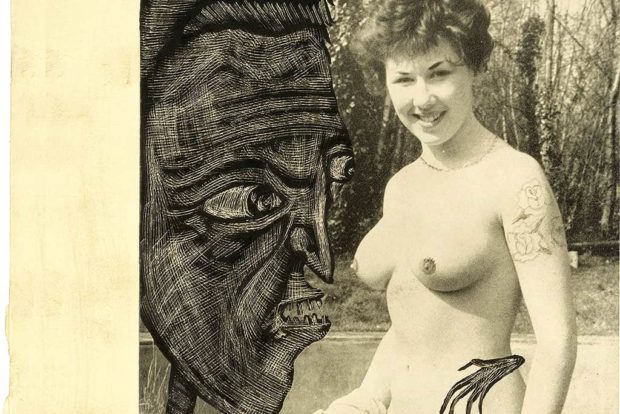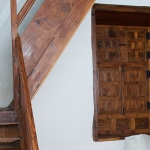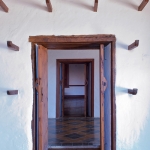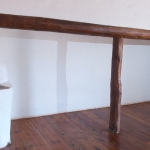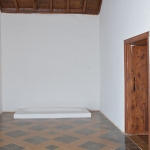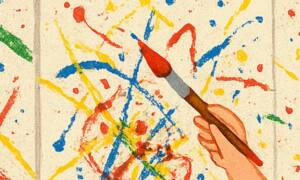-
Exposición
La Casa de los Coroneles. La chica y la pistola
10 marzo > 9 junio 2018 Desde 1 €© Dr. Lakra/Kurimanzutto, Ciudad de México
La Casa de los Coroneles. La chica y la pistola en Fuerteventura da comienzo a un programa artístico que intenta destacar los distintos méritos arquitectónicos del edificio y su ubicación en un paisaje desértico. (Más aún) con la exposición se intenta crear una comunidad artística aparte de los renombrados centros artísticos de hoy.Todo lo necesario para inventar una película son una chica y la pistola. Esta cita célebre de Jean-Luc Godard inspiró a Gustav Deutsch, el maestro austriaco de la técnica de foundfootage, a que crease la película que se proyecta en la sala oscura de la Casa de los Coroneles. Según el director, los dos grandes temas, el sexo y la violencia, dominan la historia del cine desde sus principios. La película de Deutsch es una fuente llena de imágenes de la lucha de sexos y de la fuerza destructiva liberada por los instintos y el poder. La mujer está desnuda, es lujuriosa, sumisa y amansada, pasiva e histérica. La masculinidad se define por agresividad, potencia y fuerza física. La exposición La Casa de los Coroneles. La chica y la pistola reanuda la idea que compartían Godard y Deutsch para demostrar la presencia, a veces perversa, de las mismas cuestiones en la obra de los artistas invitados.
La opresiva arquitectura colonial de la Casa de los Coroneles fue el punto de partida para cavilar sobre las categorías de dominación y sumisión, las cuales aparecen tanto en la visión arquitectónica del edificio como en algunas de las obras de artistas como Rafał Bujnowski, Miriam Cahn, Celina Kannunnikava o Jadwiga Sawicka.
El célebre Bruno Schulz utiliza las mismas categorías de dominación y sumisión para describir la primordial fuerza sexual que contiene tanto el elemento de sufrimiento como el de gozo. Schulz resalta de manera obsesiva, aun perversa, la dialéctica de determinaciones y enredos que acompaña las relaciones entre sexos. Santiago Sierra logra evocar el mismo ambiente con sus películas, aunque a pesar de la dominación en el ámbito sexual, abarca los problemas raciales y de inmigración. El tema de la (in)corrección política, racial o étnica se demuestra según varios paradigmas culturales. El difunto artista Konrad Kwasek de Szczecin, creó una serie de fotografías en blanco y negro que encontró en un álbum de familia y coloreó a mano. Kwasek estaba fascinado por representaciones de gente con distintos matices de piel como indígenas norteamericanos, negros, árabes; de ahí que, a la hora de añadir color a las fotografías, cambiaba el color de su propia piel y la de sus parientes. Grzegorz Sztwiertnia aplica un procedimiento parecido en su obra “Los trópicos” cuando pinta de negro las siluetas de turistas polacos fotografiados durante vacaciones. En la segunda parte del ciclo titulada “Países fríos”, Sztwiertnia se apropia del catálogo de fotografías de Leni Riefenstahl sacadas en los años 1960 en África. En aquella época, la directora de cine propagandístico se fascinaba por la belleza extraordinaria de los Nubios que durante las festividades teñían de blanco sus cuerpos magníficos. Sztwiertnia repintó la documentación fotográfica de aquellas ceremonias transformando el paisaje seco y lunar de África en la superficie blanca y helada del Ártico.
La exposición La Casa de los Coroneles. La chica y la pistola explora y traspasa las fronteras inestables entre lo presentable y lo inadecuado. Reúne obras cargadas con ambigüedad hacia las opuestas ideas de civilización y barbarie, hacia lo “culto” y lo “vulgar”. El artista mexicano, Dr. Lakra, contrapone de modo provocador estas categorías de normas culturales. Sus dibujos reflejan la fascinación por los fenómenos antropológicos y etnográficos: tabúes, fetiches, mitos y ritos de culturas distintas. La figura del bárbaro (del extranjero, del salvaje, del hombre primitivo, inculto, cruel, impulsivo, ignorante de la cultura europea) aparece en la exposición también fuera del contexto de la obra de Dr. Lakra. El Arte Outsider tiene sus propios bárbaros que se comunican con un lenguaje hermético (gr. Barbarophonoi, la gente que dice “bar-bar”, o sea, sonidos incomprensibles). El arte de la corriente mayoritaria se apodera de la obra de los artistas marginales a través de las estrategias contemporáneas del apropiacionismo. La definición occidental del arte “primitivo” o marginal se basa en el concepto colonizador del “Otro” que deleita al conocedor de la alta cultura con su “imaginación sin límite” y “frescor de juicio”. Un ejemplo interesante de esta excitación (documentado por la artista del performance Daria Giwer) se manifiesta en la colaboración entre Paweł Althamer y Youssouf Dara, un escultor maliense, miembro del pueblo Dogón cuyas esculturas contrastan con los dibujos de Dr. Lakra. Del mismo modo, la obra de Iwona Mysera y Władysław Grygny se compone de dibujos y cartas en las que los artistas utilizan un código secreto para describir el mundo. Construyen anotaciones escritas en su propio lenguaje en hojas sueltas de papel, mapas, libretas y calendarios. Asimismo, para subrayar la gravedad de sus acciones, Grygny pega un timbre fiscal válido en cada dibujo. La artista sueca, Marie Fahlin deriva sus acciones de las prácticas utilizadas en la terapia de trastornos del habla. En su obra sonora Fahlin aborda directamente el tema de las convenciones de dominación y sumisión en situaciones de conflicto, tales como la convivencia entre humanos y animales (la relación hombre-caballo) o entre artistas e instituciones.
BDSM, es decir Bondage y Disciplina; Dominación y Sumisión; Sadismo y Masoquismo, son términos que describen las técnicas y formas de conducta utilizadas en situaciones concretas, sobre todo sexuales. Las mismas categorías organizan las relaciones interpersonales en un sentido mucho más amplio y profundo, siempre cuando diferencias y contrastes causan tensión, tensión que excita y seduce, pero también destruye. La exposición La Casa de los Coroneles. La chica y la pistola no tiene por objetivo estudiar las injusticias sociales o la discriminación racial y de género; tampoco es un tratado sobre la corrección política. No obstante, examina los límites entre lo adecuado y lo impropio, busca tensiones y conflictos que gobiernan y determinan la vida en el mundo poscolonial de opresión y violencia.
Katarzyna Karwańska (Comisaria)
Inauguración
Sábado, 10 de marzo a las 12:00 horas.
Comisaria: Katarzyna Karwańska
Idea inicial: Rafał Bujnowski
Producción: Aleksandra Nasiorowska
Patrocina: Raster Gallery, Fundación Razem Pamoja
Organiza: Gobierno de CanariasArtistas:
- Rafał Bujnowski, nació en 1974, vive y trabaja en Cracovia (Polonia)
- Miriam Cahn, nació en 1949, vive y trabaja en Basilea y Bergel (Suiza)
- Youssouf Dara, nació en 1978, vive y trabaja en Koundou (Malí) en colaboración con Paweł Althamer, nació en 1967, vive y trabaja en Varsovia (Polonia), y Daria Giwer, nació en 1984, vive y trabaja en Kongsberg (Noruega)
- Gustav Deutsch, nació en 1952, vive y trabaja en Viena y Aegina (Austria)
- Marie Fahlin, vive y trabaja en Estocolmo (Suecia)
- Władysław Grygny, nació en 1936, vive y trabaja en Chorzów (Polonia)
- Celina Kanunnikava, nació en 1988, vive y trabaja en Poznan (Polonia) y Minsk (Bielorrusia)
- Konrad Kwasek, Szczecin, 1958 – Szczecin, 2005 (Polonia)
- Iwona Mysera, nació en 1983, vive y trabaja en Płock (Polonia)
- Jadwiga Sawicka, nació en 1959, vive y trabaja en Przemyśl (Polonia)
- Bruno Schulz, Drohobycz, 1892 – Drohobycz, 1942 (Ucrania)
- Santiago Sierra, nació en 1966, vive y trabaja en Madrid (España)
- Grzegorz Sztwiertnia, nació en 1968, vive y trabaja en Cracovia (Polonia)
The House of the Colonels. A Girl and a Gun
The House of the Colonels. A Girl and a Gun inaugurates an artistic programme that focusses on highlighting the unique qualities of the architecture and location of the eponymous building amidst a desert scenery and marks an attempt to build a contemporary art scene far away from bustling art centres.All you need to make a movie is a girl and a gun. This famous bon mot by Jean-Luc Godard provided an impulse for the Austrian virtuoso of the found-footage technique, Gustav Deutsch, to create a film screened in the intimate cinema hall of the House. According to the director, two grand themes: sex and violence, have ruled the history of cinema since its very beginning. Deutsch’s film abounds in images that depict the war of the sexes and the destructive force of drives and power. The woman is represented here as nude and debauched, submissive and tamed, passive and hysterical, whereas masculinity is defined by aggression, imperiousness and physical strength. Building on Godard’s thought, the exhibition The House of the Colonels. A Girl and a Gun demonstrates the presence of the same themes addressed in a perverse way by the invited artists.
The oppressive colonial architecture of the House of the Colonels became a departure point for a more profound reflection on the categories of domination and submissiveness, which resonate both in the architectural vision of the building and in selected works by such artists as Rafał Bujnowski, Miriam Cahn, Celina Kanunnikava and Jadwiga Sawicka. The same categories appear in works by the classic artist Bruno Schulz, who uses them to describe the primeval sexual force that combines suffering and bliss. In an obsessive or nearly perverse way, Schulz depicts a dialectic of entanglement and determination in relations between men and women. A similar atmosphere is evoked by films by Santiago Sierra. However, apart from domination in the sphere of the sexes, they also address the problem of race and immigration.
The topic of political, racial and ethnic (in)correctness is shown in the exhibition from the perspective of different cultural paradigms. The late artist from Szczecin, Konrad Kwasek, created an original cycle of hand-coloured black and white photographs from a family album. Kwasek felt a deep fascination with the image of people of colour –Indigenous Americans, Black people and Arabs– and therefore, upon repainting the photographs, he changed the colour of his own and his family’s skin. A similar procedure was used in his latest work “Tropical Countries” by Grzegorz Sztwiertnia, who covers with black paint the figures of Polish tourists in their holiday photographs. In turn, in the second part of the cycle, titled “Cold Countries”, the artist uses a catalogue of photographs created in Africa in the 1960s by Leni Riefenstahl. During her career, the propaganda film director developed a fascination with perhaps the most beautifully built people on earth – Nubians–, who adored painting their bodies white during ceremonies and festivities. The photographic documentation of those events was repainted by Sztwiertnia, who transformed the arid moon landscapes into white arctic deserts.
The exhibition The House of the Colonels. A Girl and a Gun explores and challenges the fluid borders between the appropriate and the inappropriate. It features works permeated by the ambivalence of the civilised and the barbarian, the “high-brow” and the “popular.” These opposing categories clash in the works by the Mexican artist Dr Lakra, provocative drawings that address the problem of cultural norms. The artist is fascinated by anthropological and ethnographic phenomena: taboo, fetishes, myths and rituals of different cultures. The figure of a barbarian (foreigner, savage, primitive, uncivilised, cruel man with primitive reflexes and no knowledge of European culture) appears in the exhibition not only in the context of Dr Lakra’s work. In a certain way, barbarians are also represented by outsider artists who develop a hermetic language (Gr. Barbarophonoi, or those who say “bar-bar” –utter incomprehensible sounds–) and their work is eagerly appropriated by mainstream art, for instance within the contemporary strategies of appropriation art. The Western European definition of “primitive” art or outsider art is founded on a colonising notion of the “Other,” who delights the connoisseur of high-brow art with his “untamed imagination” and “freshness of perspective.” Such excitement is exemplified in an interesting way by collaboration (documented by the performer Daria Giwer) between Paweł Althamer and Youssouf Dara –a Malian sculptor originating from the Dogon tribe–, whose sculptures are juxtaposed in the exhibition with works by Dr Lakra. In turn, the art of the outsiders Władysław Grygny and Iwona Mysera embraces drawings and letters in which the artists describe the world using an enigmatic code. They construct records in their own languages on individual paper sheets, maps, in notebooks and calendars. Additionally, in order to underscore the seriousness of his work, Grygny marks each of his drawings with an officially approved revenue stamp. In turn, the sound work by the Swedish artist Marie Fahlin (who borrows from practices used amongst people with speech disorders) directly addresses the conventions of obedience and domination in situations of conflict, for instance between a human being and an animal (relation between a man and a horse) or between an artist and an institution.
Bondage, discipline, domination, submission –BDSM– are terms that serve to describe the techniques and forms of behaviour in specific situations, usually of sexual nature. The same categories govern interpersonal relations on a much broader and more profound level every time when differences and contrasts build a tension, exciting and attractive, but also destructive. The exhibition The House of the Colonels. A Girl and a Gun does not focus on social injustice or gender and racial discrimination, it is not a treatise on political correctness. Instead, it investigates the border of the appropriate and the inappropriate as well as searches for tensions and clashes that govern and determine human life in the postcolonial world of oppression and violence.
Opening
Saturday, 10 March at 12:00 h.
Curator: Katarzyna Karwańska
Project initiator: Rafał Bujnowski
Production: Aleksandra Nasiorowska
Partners: Raster Gallery, Razem Pamoja Foundation
Institution: Gobierno de Canarias (Canary Islands Government)Artists:
- Rafał Bujnowski, born in 1974, lives and works in Cracow (Poland)
- Miriam Cahn, born in 1949, lives and works in Basel and Minsk and Bergel (Switzerland)
- Youssouf Dara, born in 1978, lives and works in Koundou (Mali) in colaboration with Paweł Althamer, born in 1967, lives and works in Warsaw (Poland) and Daria Giwer, born in 1984, lives and works in Kongsberg (Norway)
- Gustav Deutsch, born 1952, lives and works in Vienna and Aegina (Austria)
- Marie Fahlin, lives and works in Stockholm (Sweden)
- Władysław Grygny, born in 1936, lives and works in Chorzów (Poland)
- Celina Kanunnikava, born in 1988, lives and works in Poznań and Minsk (Poland, Belarus)
- Konrad Kwasek, born in 1958 in Szczecin – died in 2005 in Szczecin (Poland)
- Iwona Mysera, born in 1983, lives and works in Płock (Poland)
- Jadwiga Sawicka, born in 1959, lives and work in Przemyśl (Poland)
- Bruno Schulz, born in 1892 & died in 1942 in Drohobych (Ukraine)
- Santiago Sierra, born in 1966, lives and works in Madrid (Spain)
- Grzegorz Sztwiertnia, born in 1968, lives and works in Cracow (Poland)
